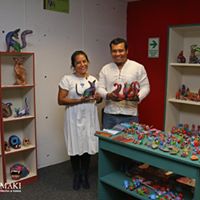Noticias
Artisans from several states of the Republic attended the event
Mexico, present for the first time at the Ruraq Maki Fair. Hecho a mano, in Peru
August 12, 2018For the first time, a delegation of Mexican artisans participated in the Ruraq Maki Fair. Hecho a Mano (Handmade), the most important traditional art exhibition in Peru brought together 140 groups of artisans from different regions of that South American country from July 19-29.
A total of six Mexican artisans traveled to Lima with the support of the Department of Culture, through the General Directorate of Popular, Indigenous and Urban Cultures, to attend this fair held at the headquarters of the Ministry of Culture of Peru and showcase some of the cultural diversity of our country.
Alebrijes, amber, earrings from Jerez, Otomi dolls, lacquer pieces and several textiles, were the crafts chosen to represent Mexico in this exhibition, which were a huge success and conquered the Peruvian public.
Elizabeth Mendoza, from Simojovel, Chiapas, said that "for us it was a success, a wonderful experience that all of us who participated in this exhibition lived. I, who went with my amber handicraft from Chiapas, was very admirable for all the Peruvians who came to visit us, they liked our handicraft and not only mine, but also the ones of the other companions, for us it was a resounding success to have participated in this event”.
It was the first time that this amber artisan traveled to another country with her jewelry pieces made with amber from Chiapas, the only place in Mexico where you can find this resin with more than 25 million years old, which is as hard as bone, although it looks plastic.
Necklaces, earrings, pendants, bracelets and rings, enchanted the Peruvians and like she said, even the staff of a museum in Lima invited them to exhibit there to promote Chiapa’s amber jewelry, resin that motivated her so much, that she was trapped like the insects that are inside the petrified amber.
Genoveva Pérez, from San Ildefonso, Querétaro, also came to Ruraq Maki with a wide variety of textiles: Otomi dolls, table runners and even tortilleros. "We did very well, excellent, we were well taken care of, the exhibition was something we didn't expect".
Although Peru is a country that also stands out for its textile work, she said that embroidery and weaving pieces predominate there, and despite the similarities in this type of handicraft, "yes, their work is very different from ours".
Having chosen us, she said, "It is to be thanked, we were privileged to go and represent Mexico, we were treated as very important people and we all bring a very good experience and impression of Peru”.
From Jerez, Zacatecas, Ricardo Trujillo participated in this exhibition Hecho a Mano with his work in silverware. "We carried the "arracada" from Jerez and it went very well, we are very grateful to the authorities of Peru and Mexico".
And it is that, he commented, his pieces had "enough acceptance on the part of the Peruvian market since we have great similarity so much in crafts as in gastronomy, the same thing in the silver, we have some type of similarity, although it is not so similar".
For the last 13 years, Ricardo Trujillo has been dedicated to the production of earrings, which can take up to four days, depending on the size of the piece, ranging from half a centimeter to 7 centimeters in diameter and whose body is made by hammering and filing, to achieve the highest quality.
It is also the first time that this craftsman has exhibited his work abroad. "We are very grateful for the invitation, it also gives us a guideline to know that we are doing things well", since in the end only the biggest pieces remained, "because of the economic issue perhaps, because as the size of the piece increases, so does the value".
The success of the first participation of a Mexican delegation in the Ruraq Maki fair. Hecho a Mano is manifested not only in the high sales that the six artisans registered but also because people wanted them to return for the next edition, which will be held in December with the assistance of Chilean artisans to make the Pacific Alliance not only commercial, but also cultural.
Elizabeth Mendoza said that the attendees "wanted us to come back for the next one, which is in December, but we talked with the Department of Culture and we know that another country is going to participate. Maybe we could be repeat next year, but for us it was very important, we lived with other artisans, we exchanged ideas”.
He described it as wonderful, a dream come true.
Mexico
